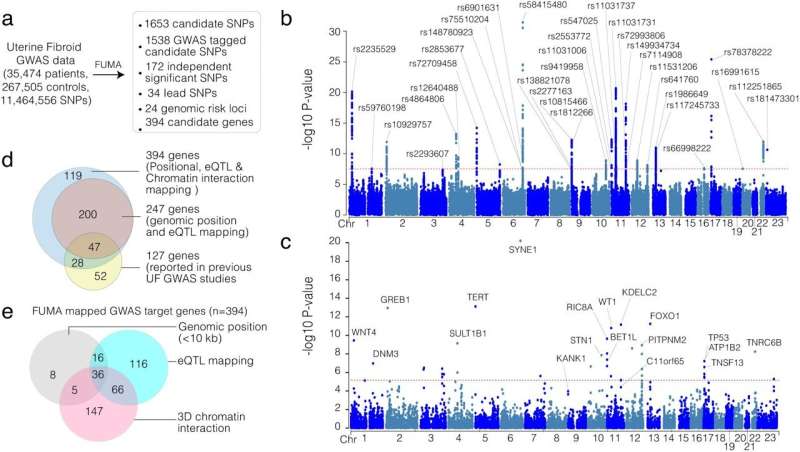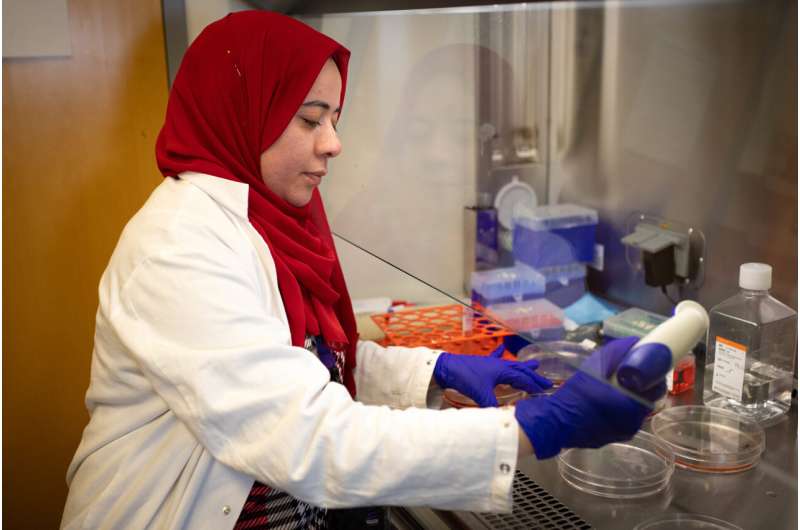This article has been reviewed according to Science X's editorial process and policies. Editors have highlighted the following attributes while ensuring the content's credibility:
fact-checked
trusted source
proofread
New genes implicated in uterine fibroid development

Northwestern Medicine scientists have identified new genes implicated in the development of uterine fibroids, according to a study published in Nature Communications.
Uterine fibroids, a type of non-cancerous growth in the uterus, are very common. About 70% of women will develop a uterine fibroid in their lifetime, according to the U.S. Department of Health and Human Services Office on Women's Health.
For most women, uterine fibroids are harmless, but nearly a quarter of those afflicted will suffer from excessive uterine bleeding, anemia and recurrent pregnancy loss.
Despite their prevalence, uterine fibroids are notoriously understudied, said Mazhar Adli, Ph.D., the Thomas J. Watkins Memorial Professor of Tumor Genomics, associate professor of Obstetrics and Gynecology in the Division of Reproductive Science in Medicine and senior author of the study.
"Uterine fibroids are not well-studied, at least not compared to other tumors," Adli said.
In the current study, Northwestern Medicine investigators performed a meta-analysis of existing fibroid genome-wide association studies representing more than 20,000 uterine fibroid cases. They identified 24 new risk loci, or locations on the human genome, where genetic variants increased the risk of developing uterine fibroids.
The investigators then integrated that information with single-cell gene expression data from uterine fibroid patients and identified causal cell types with increased expression of those high-risk genes. It was previously understood that smooth muscle cells contribute to uterine fibroids, but Adli and his collaborators found that certain immune cells also play a role, he said.
Previously, around 120 genes were thought to contribute to the risk of developing uterine fibroids. However, by integrating the 3D genomic organization data and epigenomic data, Adli's group has shown that nearly 400 genes may contribute to fibroid development.
To experimentally validate which of these genes are related to disease risk, the scientists used CRISPR-based epigenetic repression or activation of fibroid disease-associated genomic regions to narrow down and validate disease-associated genes.
"One of the significances of the study is to understand which population may be at a higher risk for uterine fibroids, but more critically, what are the potential genes that are being affected by this variance that are causing uterine fibroids," Adli said.
The study also incorporated data from people with diverse ancestries, yielding a more inclusive picture of uterine fibroid risk compared to previous studies which only analyzed patients of European ancestry, Adli said.

"Historically, a lot of these studies have been done in European ancestry populations," said Adli, who is also a member of the Robert H. Lurie Comprehensive Cancer Center of Northwestern University.
"When we took that information and compared it to a majority Black population, or Japanese population, the regions of the genome associated with disease are unique. That really shows the importance of studying diseases in diverse ancestry populations."
Now, Adli and his collaborators will build off this discovery and inhibit the identified genes in models of the disease to see if uterine fibroid growth can be halted, he said.
"The next step for us is to further understand the genetics of this disease to find which genes should we inhibit to block the development of uterine fibroids," Adli said.
More information: Kadir Buyukcelebi et al, Integrating leiomyoma genetics, epigenomics, and single-cell transcriptomics reveals causal genetic variants, genes, and cell types, Nature Communications (2024). DOI: 10.1038/s41467-024-45382-0














